Want to learn more about Bemberg? Keep reading to learn everything you need to know about the remarkable fabric.

Most people don’t think about the lining when buying clothing. It’s just something taken for granted. However, the lining is just as important as the outer fabric of a garment.
Linings do much more than just hide seams. In fact, an inferior lining made from the wrong material will make your clothing almost unwearable.
The wrong lining will:
- Trap moisture and heat inside your clothing, making you feel hot and sweaty.
- Create static so that your clothing actually clings and creeps up rather than hanging smoothly.
- Attract dust and pollen onto your clothing, making it look dirty and accelerating the need for cleaning.
- Will feel scratchy and abrade your skin.
However, a good lining will:
- Make clothing easier to put on and take off because they allow the outer fabric to easily slide over your skin or inner layers.
- Enhance the drape of your clothing
- Help keep the outer fabric clean.
- Ensure that your clothing isn’t transparent (especially important for open weave fabrics).
Bemberg is fantastic lining that ideally I’d want in all my clothing. While Bemberg is first and foremost a lining company, Bemberg fabrics can be used for much more than just lining.
What Is Bemberg?
Bemberg is the proprietary name for a cupro fabric made by Asahi Kasei, a Japanese manufacturer. While Bemberg linings are in most high-end suits and coats, it’s actually a fairly rare fabric. Only 0.02% of all fabrics produced are Bemberg.
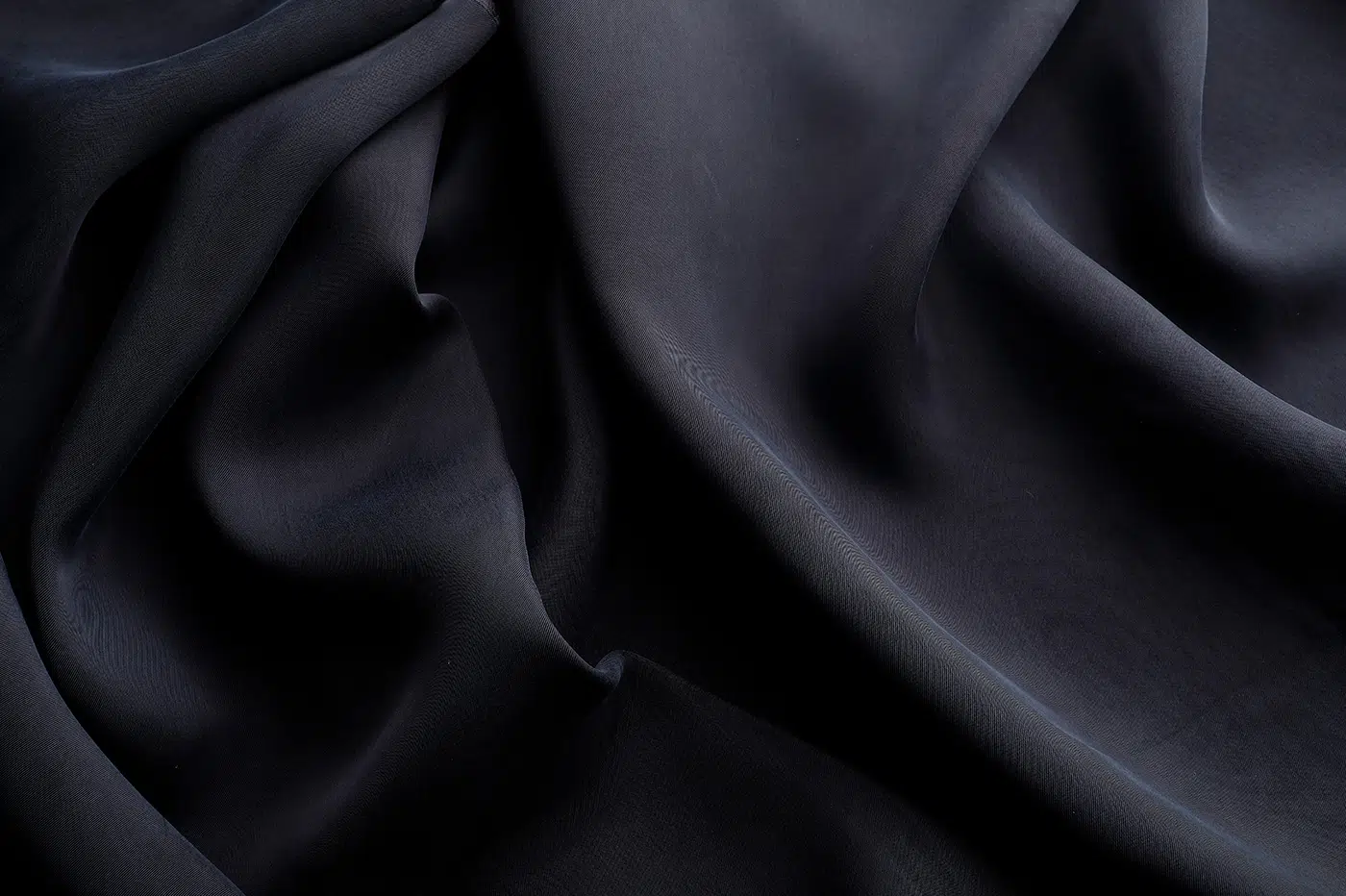
Bemberg was first manufactured in the late 19th century by J.P. Bemberg, a German rayon producer and exporter. He entered into a licensing agreement with Shitagau Noguchi in 1928. Nogushi tinkered with rayon technology, eventually resulting in his signature artificial fiber, “Bemberg.”
Noguchi began production in 1931 in Nobeoka City, Miyazaki Prefecture. Today, Bemberg is manufactured around the world, sold in 41 countries, and is used by the finest suit manufacturers including Hugo Boss, Armani, and Zegna.
What is Cupro?
Similar to rayon, lyocell, and Tencel, Cupro is a hybrid fabric.
Cupro production begins with a basic material that is natural but requires chemical processing to become usable fibers. In this case, instead of bamboo, beech, or eucalyptus fibers, cupro uses cotton linter. Cotton linter, the fuzz around the cottonseed, is a by-product of the production of cottonseed oil.

The fuzz is removed, dissolved, then transformed into pure regenerated fiber — a very fine, smooth, and round, continuous cellulose filament.
Asahi Kasei is the world’s dominant manufacturer of cupro linings. When not produced by Asahi Kasei, cupro can also be called by names such as cuprammonium rayon (the formulation that Bemberg uses), nitro silk, or ammonia silk.
The linter is mixed with ammonium and copper before being dropped into caustic soda. Finally, it is extruded through a spinneret as a filament. (Don’t worry, the ammonia, copper, and caustic soda are removed before spinning).
What Makes Bemberg Different?
Not only does Bemberg look good, it also has many unique qualities that make it perhaps the most comfortable lining fabric available. Its function is even better than its look and it all starts with the physical properties of the individual fibers.

The fibers are a uniform thickness and round. Cotton, silk, polyester, and nylon don’t have rounded fibers, so they will all be a bit rougher; a cross-section reveals that they are more flower-shaped.
Cupro fibers are also very fine so you can get a tighter weave. While many tightly woven fabrics are dense and not very breathable, the crystalline structure of cupro fibers leaves spaces between molecules through which water and air can flow.
Breathability & Moisture Control
Breathability and moisture control go hand-in-hand. If a fabric isn’t breathable, moisture from your body will get trapped and you’ll feel sweaty. Usually, you need a looser weave so that moisture can escape.
Lining fabrics are situated between your skin (or inner clothing) and your outside layers. It needs to absorb moisture and then be able to release it to the outside for you to be truly comfortable.
It’s important that linings get rid of moisture because, even if you don’t notice that you are sweating, your body is constantly releasing moisture. Everyone loses water all day long. 30% of water loss is through your breath, and the other 70% is lost by sweating. In total, you lose approximately 4 cups of water every day.
When this moisture gets trapped beneath the outer layer of clothing, you’ll feel sweaty and clammy. Picture yourself wearing a plastic bag — definitely not a comfortable thought.
The crystalline structure of cupro allows it to absorb the moisture and then release it away from your skin. In fact, it can absorb more moisture than most other fabrics before it will ever feel wet. Polyester, while it mimics the look of Bemberg, doesn’t absorb moisture at all.
However, if you blend polyester with Bemberg, it has 2.7 times the absorption rate of polyester alone. Still, why settle for anything less than the best? Personally, I’d opt for 100% Bemberg linings whenever possible.
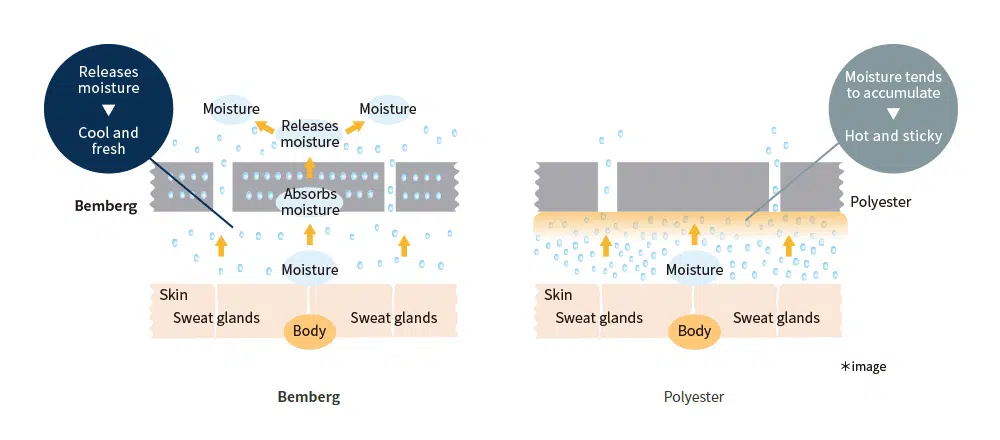
The second half of the comfort equation is breathability. Once the moisture is absorbed, it still has to be released to the outside. This is where the crystalline structure of cupro excels.
The moisture can pass through small waterways within the fiber that are invisible to the eye. Part of cupro’s secret is the amount of water that is inherent in the fibers. Cupro has a water content of 11, polyester 0.4, nylon 4.5, cotton 8.5, and silk 9.0. This means that cupro is able to retain a greater amount of moisture than other fabrics without becoming clammy.
Bemberg also has fantastic heat-releasing capabilities. Bemberg heat release rates 11, polyester 9.5, and cotton 9.0. When you consider its remarkable ability to absorb moisture, accommodate it without the wearer feeling clammy, and then release heat and moisture, Bemberg is the clear winner compared to other common lining fabrics.
Smooth & Fluid
Bemberg feels very smooth and not at all abrasive. This is part of the reason why it feels so good against your skin and why your outer layer (usually some type of wool) won’t cling.
The rounded nature of the fibers has a very low friction coefficient (Bemberg is 0.21, silk is 0.65, and polyester is 0.4).
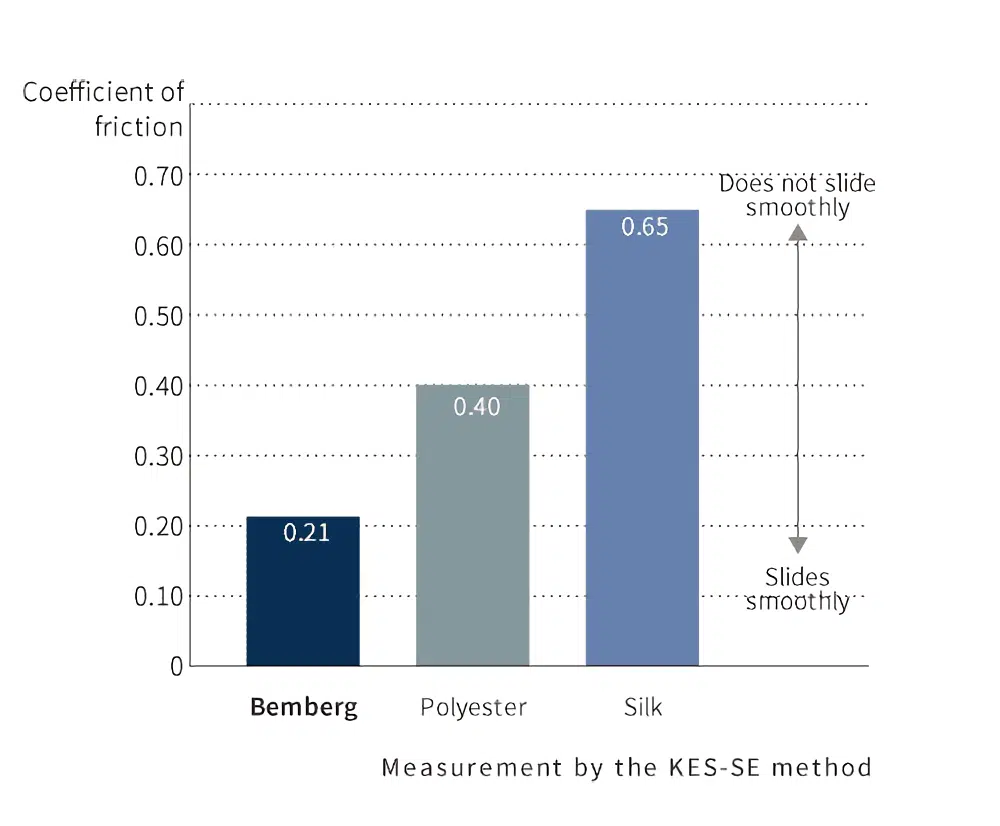
The other advantage to a low friction coefficient is that Bemberg is anti-static. Static electricity builds up when there is friction between the lining and another surface.
You may have noticed that your clothes tend to have more static cling in winter. That’s because winter is typically more dry than other seasons. Dry conditions create ideal condition for static cling to occur. However, Bebmberg helps dispel static cling. That’s because Bemberg naturally has high water content so the static electricity is discharged before it creates a clinging problem.
In one of the tests Bemberg ran to measure static, researchers compared the amount of static created by rubbing wool with either a Bemberg or polyester lining. At the end of the experiment, they found that the amount of static created with the polyester lining was more than 16 times greater than the static created with the Bemberg lining.
You can probably remember the feeling of static. Have you ever had your pant legs creep up or felt little electric shocks as you touched things? Here’s a fun video about this experiment and the anti-static properties of Bemberg.
There is one final advantage to having a low static lining: static electricity attracts pollen and dirt particles that will stick to your outer fabric.
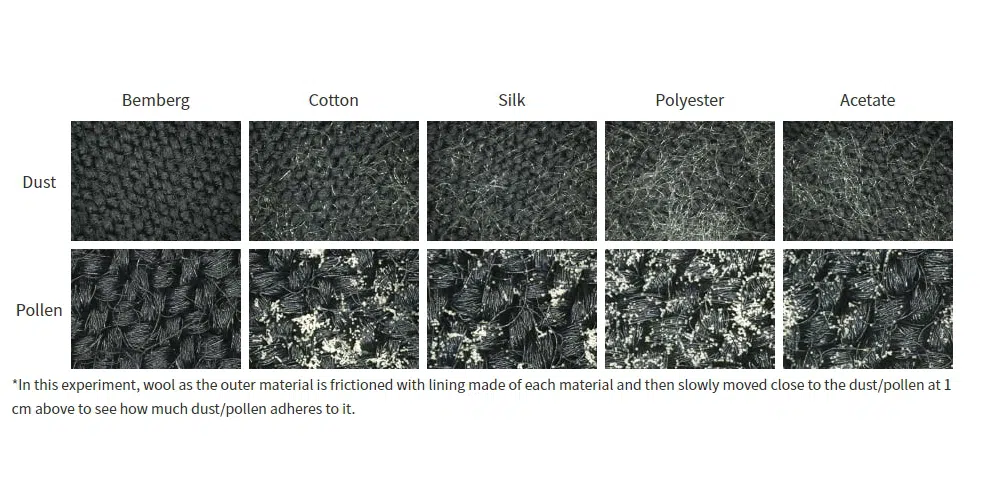
You avoid this unsightly problem with a Bemberg lining.
Unsurpassed Color
Even if Bemberg didn’t offer lustrous, deeply colored fabrics, it would make a great lining. Luckily for us, cupro accepts and retains dye better than other fabrics, including silk and cotton.
Today, Bemberg offers 152 colors with 3,000 different types of linings in weaves such as satin, taffeta, sand-washed, jacquard, twill, stripes, checks, and other patterns. They also offer some weaves in stretch versions.
Bemberg goes even further to offer the highest quality fabrics possible. Many other fabrics are piece-dyed, meaning that the fibers are woven and then dyed. This is faster and less expensive than yarn dying.
All Bemberg is yarn-dyed meaning that the fibers are dyed before being woven. This is why their patterned weaves are so vibrant and varied.
Year-Round Comfort
We’ve already discussed how Bemberg fabric releases moisture to keep the wearer comfortable, even in hot, humid conditions. Luckily, this doesn’t preclude it from also helping keep the wearer keep warm in cold conditions.
When the fabric absorbs moisture released from the body, it generates thermal energy which produces warmth. Warmth is retained when the absorbing fabric is layered with another fabric that doesn’t let the heat escape. In testing, Bemberg generated a heat index of 11 as opposed to polyester generating just 0.4.
Cupro can be a blended fabric with cotton, linen, wool, silk, and even metallics. However, most of the linings that you find will be 100% cupro.
Asahi Kasei blends can be used to make lingerie, women’s blouses and dresses, men’s and women’s shirting, workout/activewear, denim, thermal underwear, hosiery and socks, bedding and towels. Their blends are even used to create sari fabrics, which they have been manufacturing since 1954.
Care & Handling
Bemberg is generally very durable. It’s resistant to tears and rips. While some very high-end suit manufacturers and consumers have long championed silk as the ultimate lining, it isn’t nearly as strong or long-lasting as Bemberg. Bemberg is also more comfortable and less expensive than silk.
If Bemberg has any drawbacks, it’s that it can pill and wrinkle.
Due to the property modifications made to the raw fiber during manufacture, Bemberg is naturally anti-odor. It eliminates ammonia, acetic acid, and isovaleric acid (sweat) smells.
While Bemberg is washable, dry cleaning is best. If needed or preferred, it can be either hand-washed or machine-washed on a gentle cycle with cold water. It’s best to turn a Bemberg-lined garment inside out before washing. Don’t put it in your dryer and use a low heat setting when ironing.
Is Bemberg a Sustainable Fabric?
Even though Bemberg is washable and durable, it’s also biodegradable and compostable.

In fact, it can naturally break down in as little as 2-3 months. If it’s burned rather than composted, it has a much lower environmental impact than nylon, silk, wool, and polyester. Few toxic substances such as NOx (oxides of nitrogen, an atmospheric pollutant), CO, and CO2 are released.

One of the best ways to determine if you are looking at genuine Bemberg fabric is to burn it — there should be no black smoke or residue left.
Like many Japanese companies, Asahi Kasei has a clear vision of its responsibilities to its employees, the community, and the environment. They use renewable energy including hydro and biomass power generation. 40% of the power that their factories use is generated on-site.
They recycle their waste, including the chemical baths used in making cupro fiber. Their fiber scraps are burned as part of the power generation. They have almost zero waste emissions and have been certified by the Global Recycled Standard since 2017.
At the heart of their vision is the goal to:
Enrich people’s hearts and lives by creating products that have never been invented before.
Offer the highest-quality services and products as we combine rich human resources and its organizational and technological strengths
Continue creating economic and social value by adapting to a wide variety of environments.
Asahi Kasei has a number of factories around the world. They are especially active in the Far East and India. They participate in the Business Call to Action led by the UN Development Programme.
Their goal in India is to improve technology, create employment, and provide stable income opportunities.
That’s All You Need To Know About Bemberg
Many types of garments are commonly have a lining — this includes suit coats and pants, and outerwear.
That said, bad linings can rip easily, cause clothing to cling and/or creep up, and make you feel sweaty. Even though garment’s lining is as important a part of the wearer’s experience and comfort as the as the wool or leather outer layer, most people don’t stop to think about linings when purchasing new clothes. For a quality, comfortable lining, choose Bemberg.




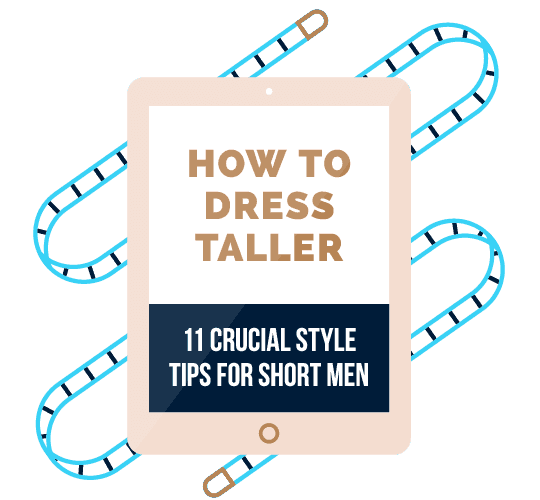

I need a light brown or tan rayon fabric to reoair my Military A-2 flight jacket lining.
Can you help supply ?
We don’t sell fabrics. We’re just an informational website.
VERY NICE ARTICLE, VERY INFORMATIVE AND HELPFULL, THANK YOU & GOOD HEALTH. FAIRBANKSA